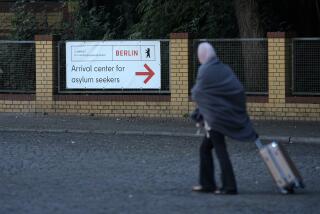Secret Bunkers Begin to See Light of Day
- Share via
BERLIN — It’s been 50 years since air-raid sirens sent thousands of Berliners racing underground into the massive concrete bunker under Alexanderplatz, carrying baskets of food and water bottles kept always at the ready.
Today, the dark passageways and rows of narrow rooms are all but forgotten, locked behind a graffiti-covered, yellow metal door that commuters rush by without a glance on their way to the subway.
But as Berlin frantically builds above ground to prepare for the resumption of its role as Germany’s capital, architectural engineer Dietmar Arnold is trying to ensure its subterranean past is not forgotten.
“From above ground there’s almost nothing left to see from the war,” says Arnold, who has turned a fascination with Berlin’s underworld into a semi-career. “Here you can see what war leads to.”
In the early days of World War II, the Nazis that boasted no enemy plane would ever reach German soil.
But after the first bomb fell on Berlin in June 1940, Adolf Hitler ordered a crash program for building air-raid bunkers nationwide.
According to the plans, the Nazis built up to 500 bunkers in Berlin, Arnold says. Many were blown up after the Allies marched into the city. Others were buried under the rubble of war or were used as foundations for new buildings.
The most notorious--a cramped complex 56 feet below the New Reich Chancellery where Hitler committed suicide on April 30, 1945--was ripped out in 1988 by the East Germans before they built an apartment complex.
Arnold, a 31-year-old native Berliner, began exploring the city’s underground remains as a child.
After getting an engineering degree, he began specializing in mapping out underground structures for city officials or construction firms that were seeking to build on a site.
From that work and through personal interviews and searches of archives, Arnold has located 195 bunkers that he and a colleague have documented in a book of photographs and a documentary film.
The bunker under Alexanderplatz in former East Berlin is one of the best preserved, partly because East Germany’s communist leaders began to renovate it as a shelter for themselves. But that project was abandoned in the 1970s.
“They ran out of money, and it wasn’t that important,” Arnold says.
Only the upper levels have electric lights, so visitors must carry flashlights to descend ramps to the bunker’s main section, which once sheltered 3,000 people 40 feet underground, sometimes for days on end.
“Ramps were built instead of stairs because there would be so many people,” Arnold says while leading the way through the maze, the stale air thick with dust.
Almost everything that could be used in the desperate early days after the war ended--wood, metal, pipes, generators--was removed, leaving a barren space.
The bunker was divided into sealed rooms, 80 people in each, for greater stability and to minimize casualties if a bomb were to break through. Hooks on the walls show where the bunks hung, stacked three high. At the far end, pipes jut from the floor where the toilets once stood.
Although fresh air was piped in through sand filters, the breathing of so many people in a small space created moisture, which collected in gullies along each side wall and was drained off. “It must have been like the tropics in here,” Arnold says.
Because of his work with the city, Arnold is one of the few Berliners with access to the underground world--not only World War II-era bunkers, but ones that were built during the Cold War to shelter 60,000 West Berliners.
Other underground works include a canal system, about 80 “blind tunnels” built in the last 100 years for subway routes that were never used or never completed, and the chalk-encrusted basement of the City Palace built by Frederick the Great and demolished by the communists in the 1950s.
“The Nazi era is just one chapter,” Arnold says.
But that chapter in particular has been closed for decades. Arnold is occasionally called upon to lead special tours for selected groups, but otherwise all the remaining bunkers are closed, their entrances kept secret.
When the bunker used by Hitler’s drivers was found in 1990 under the former no-man’s land of the Berlin Wall, some called for opening it to the public as a reminder of Nazi-era horrors.
But the city’s Culture Department decided in 1994 to seal it, fearing it would become a pilgrimage site for neo-Nazis. Today it lies behind a high metal fence, recognizable only by the slight rise it makes in the grass.
Arnold, however, hopes to win permission to offer periodic tours of Berlin’s underworld--including bunkers from the Nazi era.
He points to the nearby Topography of Terror exhibit, which incorporates cellar rooms from the former Gestapo headquarters, as proof that “one can present this theme in a reasonable and sensitive way.”
More to Read
Sign up for Essential California
The most important California stories and recommendations in your inbox every morning.
You may occasionally receive promotional content from the Los Angeles Times.










